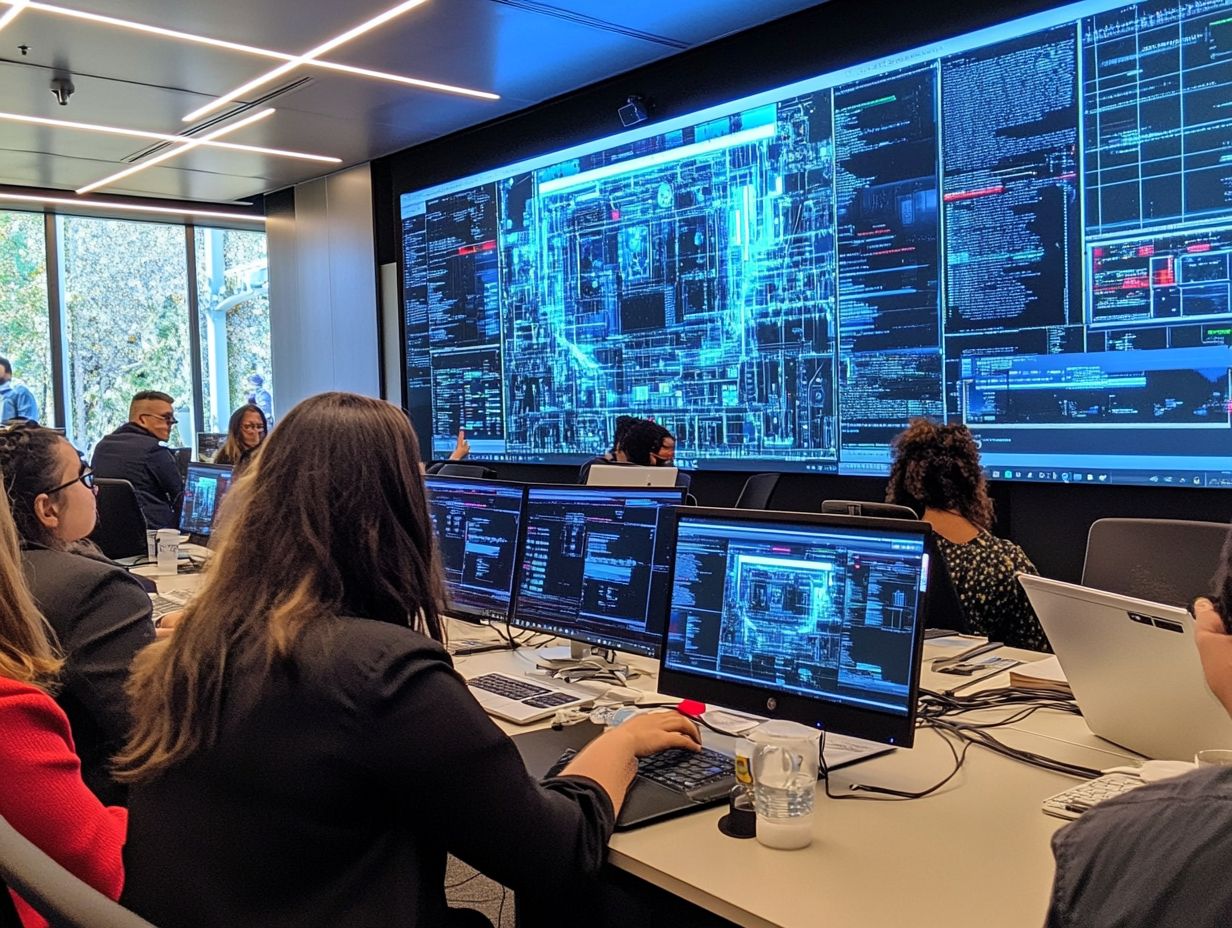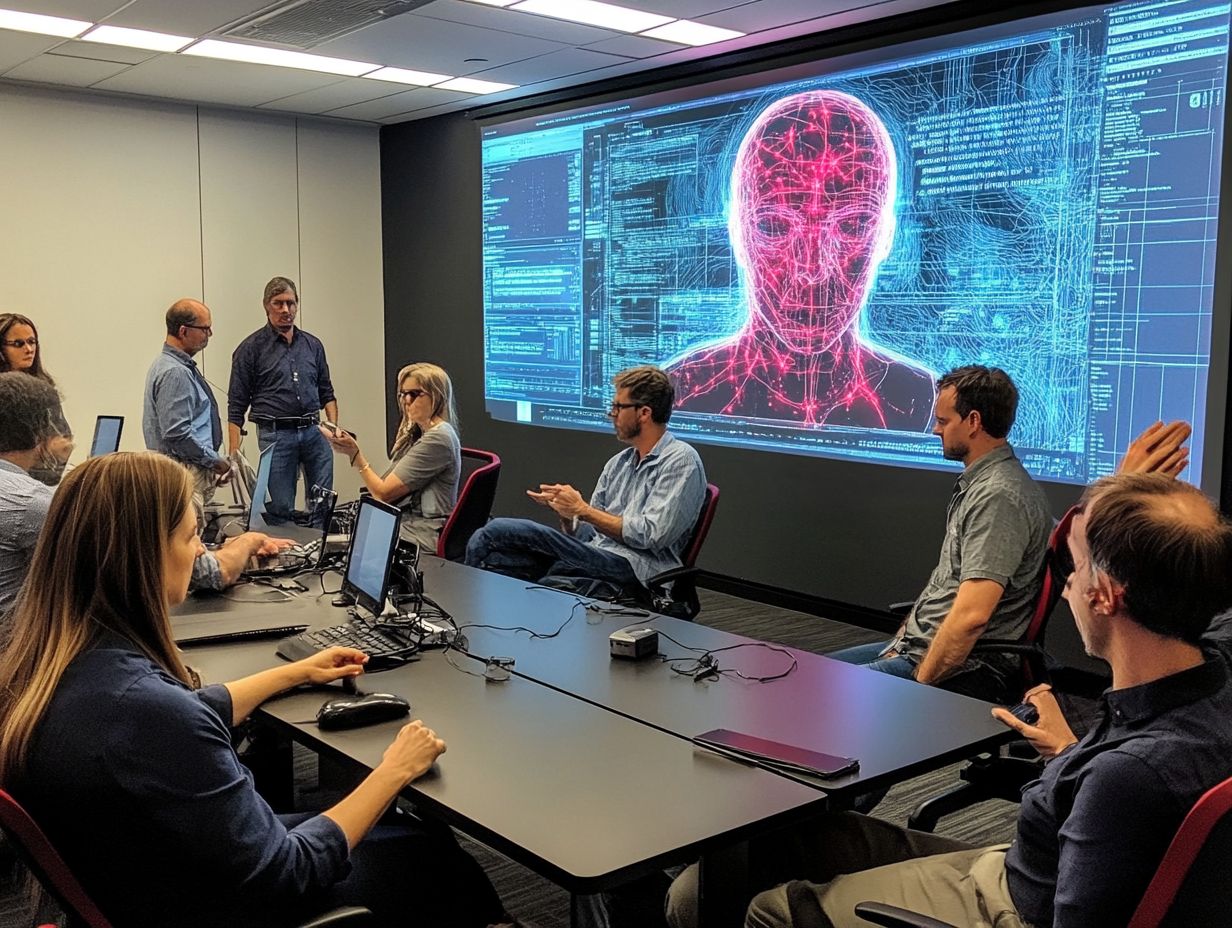the role of ai in security awareness training
In today s digital landscape, security awareness training is not optional; it is essential for safeguarding your assets. As cyber threats evolve, your training methods must adapt.
This article explores how AI can enhance the efficiency and effectiveness of security awareness training. It covers everything from simulating attacks to delivering personalized learning experiences that meet your unique needs.
We will also discuss important concerns like bias and privacy while exploring the exciting future possibilities this technology offers in this critical area.
Contents
- Key Takeaways:
- Why Security Awareness Training Matters!
- The Importance of AI in Security Awareness Training
- AI Applications in Security Awareness Training
- Potential Concerns and Limitations
- Future of AI in Security Awareness Training
- Frequently Asked Questions
- Curious about how AI transforms security awareness training? Let’s dive into some common questions!
- What is the role of AI in security awareness training?
- How does AI help improve security awareness training?
- Can AI completely replace human trainers in security awareness training?
- Is AI able to adapt to changing security threats and risks?
- What are the potential drawbacks of using AI in security awareness training?
- How can organizations best utilize AI in security awareness training?
Key Takeaways:

- AI boosts the efficiency and effectiveness of security awareness training by providing personalized and simulated attack scenarios.
- Concerns about bias and privacy can be addressed by implementing ethical standards in AI-based training.
- The future of security awareness training looks promising with advancements in AI technology, offering more effective and targeted training options.
Why Security Awareness Training Matters!
You must participate in Security Awareness Training to protect yourself and your organization. It equips you to understand various security risks and threats you might face at work, focusing particularly on phishing attacks and data breaches. This training fosters a culture of compliance, ensuring you recognize your role in safeguarding sensitive information and maintaining data privacy.
Engaging in effective training methods not only enhances your knowledge and skills but also improves your organization s overall security posture, reducing vulnerabilities.
This training aligns seamlessly with compliance laws, such as the General Data Protection Regulation (GDPR) and the Health Insurance Portability and Accountability Act (HIPAA), which mandate organizations to protect sensitive data. The goal is to equip you with best practices that significantly mitigate risks associated with human error.
Once you grasp the potential impact of a data breach, you are more likely to adopt proactive behaviors, such as recognizing suspicious emails and properly handling sensitive information.
Embracing Security Awareness Training is not just about ticking a regulatory box; it s a crucial step towards cultivating a vigilant and responsible workforce that prioritizes security.
The Importance of AI in Security Awareness Training
The integration of AI into Security Awareness Training is revolutionizing how you educate employees about cybersecurity. It enhances both efficiency and effectiveness.
With smart computer programs that learn from data, AI tailors training materials to meet your workforce’s unique needs, creating personalized and engaging learning experiences.
By automating assessments and providing real-time insights into user behavior, you gain a clearer understanding of the threat landscape. This allows you to continuously refine and elevate your security training processes.
Enhancing Efficiency and Effectiveness
Enhancing the efficiency and effectiveness of Security Awareness Training is essential for organizations committed to mitigating security risks. AI is a crucial ally in this endeavor.
By harnessing real-time data analytics, you can customize training programs to address specific vulnerabilities and adapt to evolving threats. This maximizes employee engagement and knowledge retention.
This level of customization personalizes the learning experience and allows you to implement targeted assessments that effectively measure understanding and retention.
Incorporating engaging techniques, such as gamification and interactive scenarios, cultivates a culture of security awareness. This makes the learning process enjoyable while reinforcing critical concepts.
By leveraging AI-driven insights, you can continuously refine these techniques to keep them relevant and impactful. This ultimately paves the way for a more vigilant workforce, equipped to recognize and respond to potential threats with confidence.
In conclusion, implementing AI in your security awareness training programs is crucial for enhanced security. Don t wait take the first step toward a more secure future now!
AI Applications in Security Awareness Training

AI applications in Security Awareness Training are revolutionizing cybersecurity education. They provide tools and techniques that elevate learning outcomes.
By leveraging AI-driven simulations, organizations can effectively replicate real-world phishing attacks. This enables employees to confront these threats in a safe and controlled setting.
Personalized training modules powered by AI ensure every employee receives customized content tailored to their unique learning styles and specific roles within the organization.
Using AI for Simulated Attacks
Using AI for simulated attacks has become essential in Security Awareness Training. It offers hands-on experience in identifying and responding to threats.
These simulated scenarios not only enhance awareness but also allow organizations to assess their security posture. This readiness is crucial against potential incidents.
By incorporating advanced algorithms, AI-generated simulations can mimic real-world attack methods. This provides a realistic experience that captures the nuances of genuine cyber threats.
This approach fosters a proactive security culture and equips employees with the skills needed to recognize and thwart attacks before they escalate. These training exercises help organizations identify knowledge gaps and refine protocols.
As the world of cybersecurity is always changing, understanding how to navigate these simulated challenges becomes critical. It ensures employees are well-prepared to face actual incidents with confidence.
Personalized Training with AI
Personalized training with AI enables organizations to tailor Security Awareness Training to the distinct needs of each employee. This significantly enhances engagement and skill acquisition.
By analyzing individual learning styles and prior knowledge, AI crafts customized learning paths. This ensures the team gains the essential skills and knowledge to effectively combat cybersecurity threats.
The tailored approach keeps employees motivated and engaged. It also dramatically improves their retention of critical information.
When implementing these advanced training modules, you ll see real-time progress and can quickly adjust based on performance. Consequently, employees become more adept at identifying potential risks and displaying proactive behaviors.
This fosters a robust culture of security awareness throughout the organization. Leveraging AI in training accelerates personal growth and strengthens defenses against the ever-evolving challenges of cybersecurity.
Potential Concerns and Limitations
While the benefits of AI in Security Awareness Training are substantial, it’s essential to remain aware of potential concerns and limitations. This is particularly true when it comes to bias and privacy issues.
As organizations lean more heavily on AI technologies, addressing the ethical implications of automated training processes becomes crucial. It’s vital to tackle these concerns head-on to create a safe learning environment.
Your responsibility is to ensure that the training content is fair and does not inadvertently reinforce biases that could adversely affect employee education.
Addressing Bias and Privacy Issues

Addressing bias and privacy issues is essential as you implement AI in your Security Awareness Training programs. Doing so ensures ethical decision-making and fosters trust among your employees.
By actively seeking to identify and mitigate potential biases within your training algorithms, you can create a more equitable training environment that respects employee privacy.
To accomplish this, it s important to establish clear guidelines for regularly auditing your AI systems. Involve diverse teams in the development process and utilize effective feedback mechanisms.
This proactive approach helps catch and fix biases early. It also follows privacy laws that protect people’s rights. These legal frameworks guide you toward responsible practices while enhancing the integrity of your AI-operated training modules.
Emphasizing transparency in your AI-driven processes is not just a compliance issue; it s vital for cultivating a culture of accountability and openness. Your employees are far more likely to engage with training programs that showcase a genuine commitment to ethical standards and privacy.
Future of AI in Security Awareness Training
The future of AI in Security Awareness Training presents remarkable opportunities for enhancing organizational cybersecurity and enabling employee education.
As technology races forward, exciting new AI solutions are on the horizon! You can expect AI-driven solutions to become more sophisticated, allowing your organization to actively deal with new threats.
Don t miss out on these advancements start exploring how AI can transform your training today!
Advancements and Possibilities
Advancements in AI technologies open up remarkable opportunities for enhancing Security Awareness Training. You can effectively combat real-time threats and elevate your overall cybersecurity posture.
As AI continues to evolve, you can leverage these advancements to create interactive and adaptive training experiences that resonate with your employees. This ultimately cultivates greater awareness against security incidents.
These innovative tools enable you to analyze employee behavior and pinpoint potential weaknesses. You can offer personalized training solutions tailored to individual learning styles.
Machine learning algorithms are computer programs that learn from data to improve their performance over time. For example, they can identify patterns in phishing attempts and help you simulate realistic attack scenarios within your training modules.
AI analytics provide actionable insights on training effectiveness, guiding you to adjust methods based on performance metrics. By integrating these intelligent technologies, you foster a proactive security culture and enable your employees to become vigilant defenders against cyber threats.
Frequently Asked Questions
Curious about how AI transforms security awareness training? Let’s dive into some common questions!
What is the role of AI in security awareness training?

The role of AI in cybersecurity awareness training is to enhance effectiveness and efficiency by automating certain tasks. It also provides personalized learning experiences for employees.
How does AI help improve security awareness training?
AI can help improve security awareness training by analyzing areas where employees may struggle or need additional training. It tailors content to individual learning styles and provides real-time feedback and simulations.
Can AI completely replace human trainers in security awareness training?
No, AI cannot completely replace human trainers in security awareness training. While AI can automate certain tasks and provide personalized learning experiences, human trainers are essential for guidance, answering questions, and facilitating discussions.
Is AI able to adapt to changing security threats and risks?
Yes, AI is able to adapt to changing security threats and risks. Through machine learning and data analysis, AI can continually update and improve training content to address the latest threats in the digital landscape.
What are the potential drawbacks of using AI in security awareness training?
Using AI in security awareness training has some drawbacks. These include high upfront costs, possible biased algorithms, and reduced human interaction.
How can organizations best utilize AI in security awareness training?
Organizations can maximize AI’s potential by collaborating with skilled AI developers. They should also define clear training goals and regularly assess the system’s effectiveness.
Human elements like trainers and personal interactions must be included to enhance the training experience.






